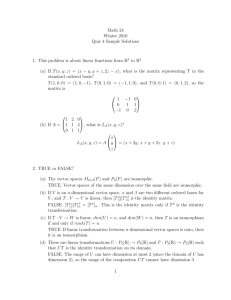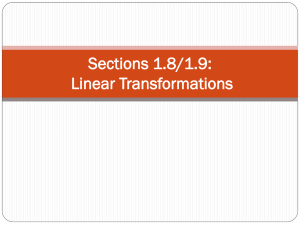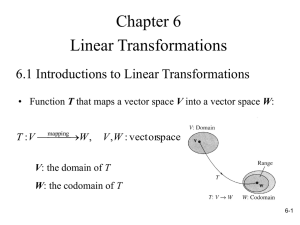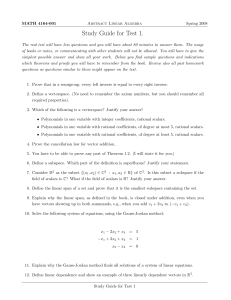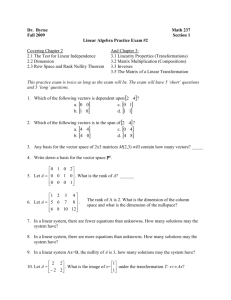A new model for the Euclidean Plane ( E ),
advertisement
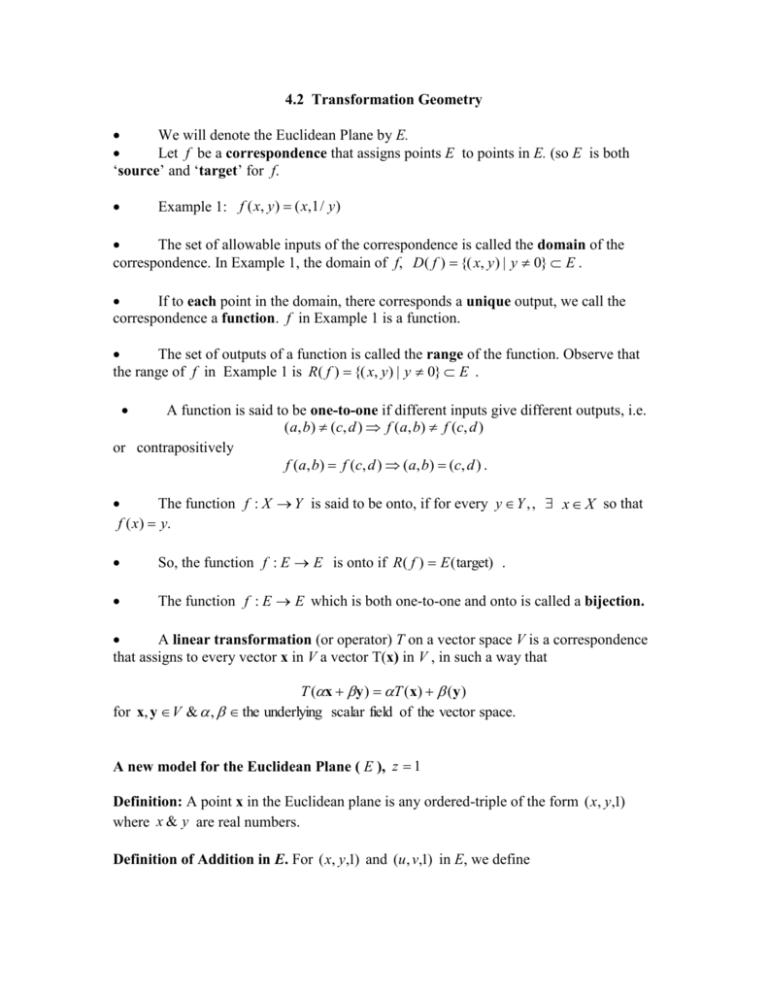
4.2 Transformation Geometry
We will denote the Euclidean Plane by E.
Let f be a correspondence that assigns points E to points in E. (so E is both
‘source’ and ‘target’ for f.
Example 1: f ( x, y ) ( x,1/ y )
The set of allowable inputs of the correspondence is called the domain of the
correspondence. In Example 1, the domain of f, D( f ) {( x, y ) | y 0} E .
If to each point in the domain, there corresponds a unique output, we call the
correspondence a function. f in Example 1 is a function.
The set of outputs of a function is called the range of the function. Observe that
the range of f in Example 1 is R( f ) {( x, y ) | y 0} E .
A function is said to be one-to-one if different inputs give different outputs, i.e.
(a, b) (c, d ) f (a, b) f (c, d )
or contrapositively
f ( a , b ) f ( c , d ) ( a , b ) ( c, d ) .
The function f : X Y is said to be onto, if for every y Y , , x X so that
f ( x) y.
So, the function f : E E is onto if R( f ) E ( target) .
The function f : E E which is both one-to-one and onto is called a bijection.
A linear transformation (or operator) T on a vector space V is a correspondence
that assigns to every vector x in V a vector T(x) in V , in such a way that
T (x y ) T (x) (y )
for x, y V & , the underlying scalar field of the vector space.
A new model for the Euclidean Plane ( E ), z 1
Definition: A point x in the Euclidean plane is any ordered-triple of the form ( x, y,1)
where x & y are real numbers.
Definition of Addition in E. For ( x, y,1) and (u , v,1) in E, we define
( x, y,1) + (u , v,1) = ( x u , y v,1) .
Definition of Scalar multiplication in E. For ( x, y,1) in E, we define
( x, y,1) = (x, y,1) .
Claim: ( E ,,) is a vector space.
A point x ( x, y,1) in the plane is identified with the 3 1 matrix x
y 1]
T
Consider the map, T : E E defined by T ( x) Ax
where
a b c
A e f g with A 0
0 0 1
Observe:
a b c x ax by c
1.
Ax e f g y ex fy g E
0 0 1 1
1
2.
3.
4.
5.
T is one – to – one (prove)
T is onto (prove)
T is has a unique inverse (prove)
T is a linear transformation (prove)
Theorem:
The image of a line L u
v
a
w under a linear transformation A e
0
b
f
0
c
g
1
is given by LA 1 kL'
Exercises
1.
Given a linear transformation T, the image of a point X under the transformation
is given by the matrix equation TX X ' . The matrix of T relates the coordinates of an
object X to the coordinates of its image X’ under the linear transformation. What matrix
relates the parameters of an object line L to its image L’ under the same linear
transformation.
2.
How many sets of object-image points are necessary to uniquely define a linear
transformation. Why?
3.
Demonstrate by example that the composition of linear transformations is not
commutative.
4.
Demonstrate by example that composition of linear transformations is associative.

